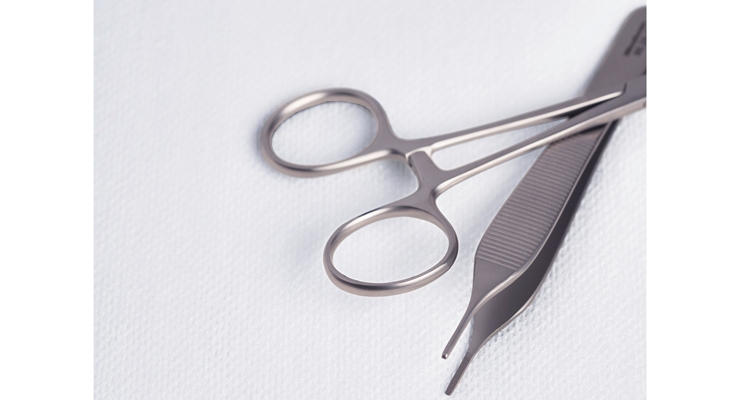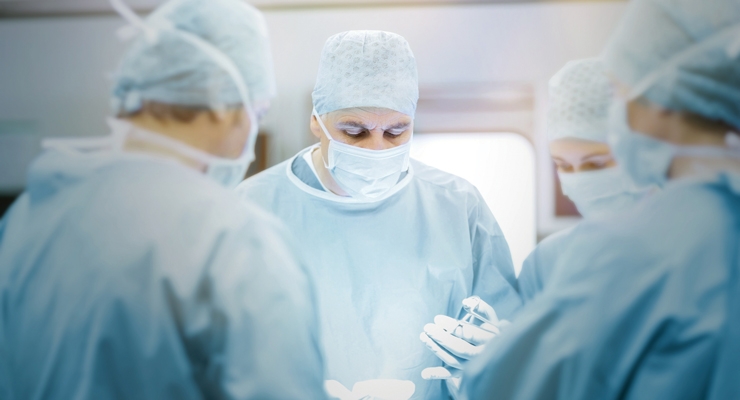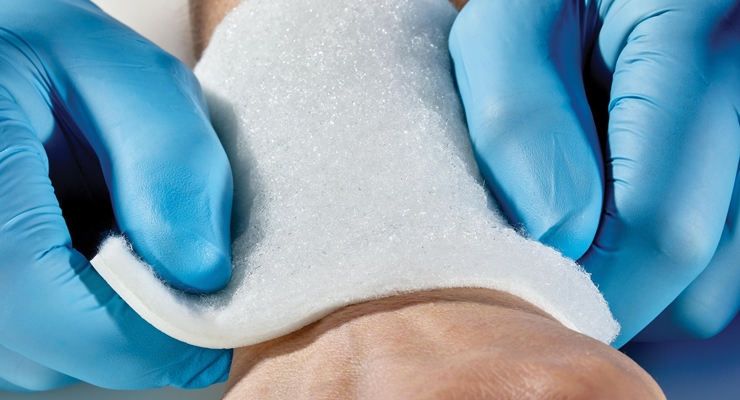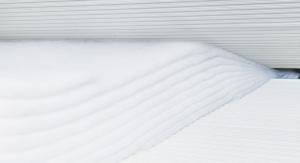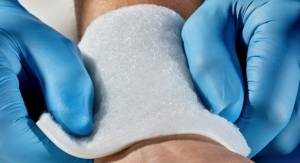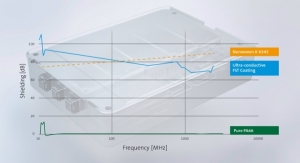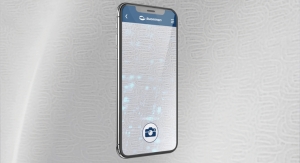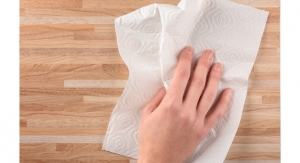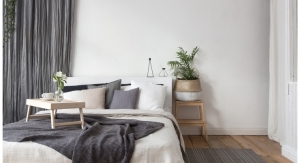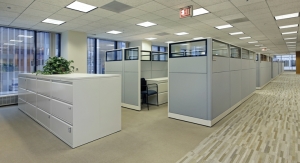Tara Olivo, Associate Editor08.05.19
New applications and increased usage of medical nonwovens continues to drive the market forward.
Surgical drapes and gowns, including other surgical pack components, account for almost 67% of all medical nonwovens, by value and tonnage, according to a new Smithers Pira market study, The Future of Global Nonwovens to 2024. In North America, these disposable nonwoven-based products account for 90% of all surgical drapes and 95% of all surgical gowns, the U.K.-based research firm reports.
“If we compare single-use nonwovens with traditional reusable materials in gowns and drapes, we will see that the benefits of nonwovens are clear,” says Johanna Síren, category manager of Finnish nonwovens producer Suominen. “Even though the reusable materials have evolved, studies still favor disposable gowns and drapes as having a more solid, reliable and reproducible bacterial impermeability. With reusable gowns, these properties seem to fade with wetting or repeated wash. Moreover, the single-use materials are easy-to-use, safe to dispose and also an economical solution.”
According to the Smithers Pira study, nonwoven-based face masks are also expected to witness growth with rising fear of infectious diseases such as SARS or H1N1 swine flu. Worldwide value for nonwovens in medical applications will be $1.28 billion in 2019, and further growth will continue at a rate of 4.6% year-on-year to yield a market worth $1.61 billion in 2024.
Another growth area for nonwovens in the medical market is wipes.
Medline, a global manufacturer of medical supplies, recently entered the CHG (chlorhexidine gluconate) cloth market with its new FDA-approved ReadyPrep CHG cloths. Used for patient pre-operative skin prep, the cloths are pre-saturated with 2% chlorhexidine gluconate, an antiseptic known for its ability to remove infection-causing bacteria from the skin, which can help reduce the risk of surgical site infections (SSIs).
“Approximately 160,000-300,000 SSIs occur in the U.S. each year with an associated cost of $34,407 per treatment,” says Alana Cecola, director of Product Management, Readycare, Medline Industries. “Healthcare is looking for options to deliver an antiseptic agent consistently, safely and effectively to reduce the risks associated with SSIs. As one of the leaders in healthcare manufacturing and distribution, Medline wanted to provide them with an option.”
Medline also manufactures a variety of spunlace, needlepunch and dispersible based pre-moistened personal cleansing cloths, which are a more sanitary, standardized approach that can offer better skin care and patient experience over traditional cleansing methods, Cecola says. “The wide adoption of pre-moistened personal cleansing cloths has made the solutions very cost effective for healthcare facilities.”
According to Cecola, the U.S. has been steadily growing in personal cleansing cloths. “Other regions have been slower and more resistant to change but with supporting evidence showing the impact on outcomes, other markets should grow in next five to 10 years,” she adds.
Safety First
Studies have shown the benefits of nonwovens compared to reusable materials, as nonwoven-based products are more likely to reduce instances of infection and lessen the opportunity for cross-contamination.
For decades, Ahlstrom-Munksjö has been developing nonwoven medical fabrics that are used for surgical gowns, protective apparel, sterilization wraps, drapes, face masks and coveralls.
Based on the levels of fluid protection needed, the company has a range of products such as SMS (spunbond meltblown spunbond) for basic performance, or with added properties like anti-static for medium performance and alcohol repellent for high performance and comfort. “SMS is a multi-layer nonwoven fabric made up of a top and bottom layer of spunbond polypropylene for strength and a middle layer of meltblown polypropylene for filtration,” explains Melanie Burakouski, global market development manager, Ahlstrom-Munksjö.
For protection against viruses, bacteria and fluids, Ahlstrom-Munksjö offers a breathable viral barrier (BVB) fabric, which is a tri-laminate consisting of a spunmelt outer and inner layer with a breathable monolithic film layer.
Last fall the company launched its next generation BVB surgical fabric, ViroSel, which is constructed for the most critical areas of a surgical gown designed to keep medical professionals protected and comfortable. “We leveraged our decades of experience to create a fabric that can be reliably used to make the most protective and comfortable surgical gowns on the market,” Burakouski says.
The fabric is constructed to be impervious, breathable and comfortable. The outer layer is fluid repellent and durable. The barrier layer has a reformulated monolithic film membrane making it impervious to liquids, viruses and bacteria, while the chemical composition of the film itself allows moisture vapor to pass through it, keeping the surgical staff cool and dry. The darker inner layer is designed to reduce shadowing and is soft to the touch, which makes it comfortable to wear for long periods of time, according to Burakouski.
“Surgeries like cesarean sections, gastric and cardiac often have a substantial amount of fluids involved and are lengthy to complete,” she explains. “This means protection and comfort are essential for the medical professionals wearing the surgical gown. Infection control is imperative as there is risk to the patient and staff to potentially come into contact with these fluids. International industry standards are used to test and measure the barrier performance for liquids and blood-borne pathogens for materials used in protective clothing like surgical gowns. ViroSel passes these stringent standards providing the impervious protection needed in the surgical environment.”
Suominen also offers a range of technologies for the medical market. A specialty 100% cotton entangled nonwoven called Webril is designed for medical applications requiring high absorbency and easy tear. “These attributes provide superior performance for the cast padding and wound care markets. This technology supports clinician’s desire for sustainable options in the medical market,” says Suominen’s Síren.
The company also manufactures proprietary thermal bond nonwovens called Novonette consisting of a high amount of natural fibers offering high absorbency, quick fluid release characteristics, softness and drapeability. It can incorporate super absorbent fibers within the thermal bond for applications requiring extra absorbent capacity.
And, as one of the global leaders in spunlace, Suominen can offer color capabilities and patterns for visual cues as well as ability to include pulp and other nonwovens in medical structures. Its newest wetlaid line in Bethune, SC, also employs a wide range of raw materials to deliver unique solutions for the medical market.
The functionality and features of medical nonwovens vary remarkably from one technology to another, Síren points out. In drapes, Suominen’s Fibrella Zorb+ material is used in drape fenestration areas thanks to its excellent properties: its absorption capacity is twice as fast as competitors’ products made of spunbond, she claims. “This way it reduces post-operative cleanup time. It is also easily drapable and conformable, which is a great benefit for example when compared to airlaid.”
Meanwhile, Suominen’s Fibrella Perf product family, which is offered globally, was developed for wound care products where its softness, skin-friendliness and absorbency are valued. This range was recently introduced to South American markets. “We are seeing strong growth in Latin America where we invested at our plant in Brazil,” Síren says. “The investment has enabled us to supply medical products from the plant as well. There, we are seeing replacement of traditional textiles but also totally new application areas.”
Jacob Holm Group is a leading innovator of spunlace nonwoven fabrics and finished goods. Their nonwovens can be found in markets ranging from hygiene and consumer wipes to health care and skin care and industrial cleaning under the Sontara, Sontara Beauty, SoftFlush and SoftLite brands. The Sontara brand was acquired from DuPont in 2014, and with it, a unique manufacturing process that is free from binders, chemicals and adhesives. This results in a high-purity fabric that minimizes the possibility of product contamination and allergic reactions by users, according to the company. Within this manufacturing process, Sontara can use a broad variety of fiber technologies, which allows for a wide range of high-performing, customized fabrics for diverse healthcare applications.
“Our unique manufacturing process and trusted supply chain ensure that Sontara nonwoven fabrics perform to the highest specifications required for medical nonwoven products,” says Jacob Holm CEO Martin Mikkelsen. “Sontara fabrics are clean at each use, minimizing the risk of infection, providing superior dimensional strength, and offering softness and comfort to the wearer.”
For medical apparel, Sontara fabrics are soft to the touch and, through advanced material technology, provide a breathable, fluid-repellent barrier. “The excellent air permeability of Sontara provides the O.R. staff with optimal ventilation and better drapeability than any SMS product on the market, ensuring maximum comfort needed to perform critical procedures right,” explains Mikkelsen.
In wound care, Jacob Holm’s high-purity Sontara fabric minimizes the possibility of product contamination and allergic reactions by users. It is also low linting, limiting the risk of introducing particulates. “The dimensional stability of Sontara fabric ensures that it stays in place without over-stretching or becoming misshapen,” Mikkelsen adds.
More recently, Jacob Holm has focused its research on developing fabrics that fill unmet needs. As a result, its product range has expanded to include additional sustainable solutions for medical apparel and wound care. Its current products include up to 50% sustainably-sourced raw materials, and the company is catering to the need for plastic-free products through innovating with novel raw materials and processes.
“As the commitment to sustainability grows worldwide, it has become increasingly important to offer cost-effective nonwoven materials with both eco-friendly raw materials and a clean manufacturing process,” Mikkelsen says. “This global shift in perspective offers opportunities across applications for spunlace technology. Unlike other technologies, spunlace utilizes high pressure jets of water to bond the web. This completely removes binders, chemicals and other adhesives from the production process and therefore the final product. This creates an environment where it is possible to produce fabrics with 100% sustainably-sourced raw materials that stay pure from start to finish.”
Healing Wounds
Freudenberg Performance Materials’ has developed nonwovens and polyurethane foams to the medical and wound care industry for more than three decades. It creates components for traditional and advanced wound care, bioactive wound care, ostomy and transdermal applications. Within medical, the company uses drylaid, spunlaid, wetlaid and foams as base technologies, which are combined with a wide variety of coating and finishing technologies. “This package allows Freudenberg Performance Materials to tailor product offerings and characteristics that exactly meet customer needs,” says Dr. Frank Heislitz, CEO, Freudenberg Performance Materials.
Freudenberg Performance Materials has recently introduced several innovations. Among them are multilayer foam-nonwovens components with superabsorbent nonwovens. By combining hydrophilic PU foams and hydroactive nonwovens for wound dressings, absorption and retention performance significantly increases. “All components are optimally matched to each other,” says Dr. Heislitz. “This is possible because Freudenberg is one of the few suppliers on the market to develop and manufacture the materials used as well as laminate them in-house.”
Customers can choose between MDI- and TDI-based hydrophilic polyurethane foams. Freudenberg manufactures these high-performance multilayer materials in cleanrooms under ISO 13485 conditions.
Freudenberg has also developed more efficient PU foams. Thanks to the newly developed, high-performance formulation based on MDI polyurethane, Freudenberg offers a superior alternative to conventional TDI-based PU foams. As a component of wound dressings for chronic venous leg ulcers, the new MDI-based PU foam absorbs wound fluids in just a few seconds. It also has a fluid retention capacity that is around 50% higher than that of the TDI foam and offers much greater strength in its wet state.
“The healthcare and wound care market is very heterogeneous with many niche products,” Dr. Heislitz explains. “Freudenberg Performance Materials focuses on medical solutions that improve the healthcare outcomes. The company sees opportunities for multilayer solutions that reduce the overall cost of care, e.g. with better healing performance, reduction of product complexity on the customer side and simplify the supply chain.”
Made in Turkey
Like many other different applications, Turkish nonwovens producer Mogul, based in Gaziantep, also has a customer portfolio for medical nonwovens thanks to various production technologies being operated by the company. Today, it offers polypropylene SMS type of fabrics for medical/surgical gowns and robes, polypropylene spunbond and meltblown for face masks, Aqualace (parallel-laid spunlace) fabrics for surgical swabs, Mopet (100% polyester spunbond) for blood filtration and various qualities of its Madaline fabric (PET/PA6 microfilament) for medical packaging and medical clothing. The Madaline fabric inherently has 94.5% bacterial filtration efficiency and anti allergic properties. Finally, its Durell brand cross-lap spunlace can be used for medical tapes and bandages.
“Nonwovens bring cost efficiency as single use products, they help to prevent cross contamination with their disposable nature and they bring some anti barrier properties which can’t be meet by textiles,” says Serkan Gogus, CEO of Mogul.
The company expects to see growth in the market, especially in developing regions of the world with increased income where more disposable products will be used to replace conventional textiles, and in developed regions where disposables help prevent hospital infections.
Felix Nonwovens, of Eskisehir, Turkey, manufactures spunbond nonwovens, films and laminated nonwoven products, mainly serving the hygiene and medical industries. Its main product portfolio of polypropylene spunbond nonwovens is used in hydrophobic gown fabrics or hydrophilic drape laminates. Its cast films can be made from polyethylene or polypropylene, and can also be made as a complete barrier to bacteria and viruses, or breathable. At later stages these nonwoven are bonded with barrier or breathable cast film in order to form laminated layers.
Felix recently invested in a new hotmelt lamination system that is able to increase its capacity for SFS Breathable Barrier AAIM Level 3 and 4 gown fabrics and also AAIM level 4 hydrophilic surgical drape fabrics. “In addition to that, we are now able to provide other side products that are used in the industry such as mayo tool table covers, incision films, tool table covers, op tapes and other double sided tapes along with pouches,” says Felix’s Ali Serdar Serteser.
With the possibility of vertical integration with a medical textile converting facility, Felix is also able to provide semi finished or finished gowns, drapes and packs. “This enables our customers and partners to be more flexible with their needs. We are able to provide OBL, private label services and also still continue to supply high quality fabrics to the market as our main business,” he adds.
Surgical drapes and gowns, including other surgical pack components, account for almost 67% of all medical nonwovens, by value and tonnage, according to a new Smithers Pira market study, The Future of Global Nonwovens to 2024. In North America, these disposable nonwoven-based products account for 90% of all surgical drapes and 95% of all surgical gowns, the U.K.-based research firm reports.
“If we compare single-use nonwovens with traditional reusable materials in gowns and drapes, we will see that the benefits of nonwovens are clear,” says Johanna Síren, category manager of Finnish nonwovens producer Suominen. “Even though the reusable materials have evolved, studies still favor disposable gowns and drapes as having a more solid, reliable and reproducible bacterial impermeability. With reusable gowns, these properties seem to fade with wetting or repeated wash. Moreover, the single-use materials are easy-to-use, safe to dispose and also an economical solution.”
According to the Smithers Pira study, nonwoven-based face masks are also expected to witness growth with rising fear of infectious diseases such as SARS or H1N1 swine flu. Worldwide value for nonwovens in medical applications will be $1.28 billion in 2019, and further growth will continue at a rate of 4.6% year-on-year to yield a market worth $1.61 billion in 2024.
Another growth area for nonwovens in the medical market is wipes.
Medline, a global manufacturer of medical supplies, recently entered the CHG (chlorhexidine gluconate) cloth market with its new FDA-approved ReadyPrep CHG cloths. Used for patient pre-operative skin prep, the cloths are pre-saturated with 2% chlorhexidine gluconate, an antiseptic known for its ability to remove infection-causing bacteria from the skin, which can help reduce the risk of surgical site infections (SSIs).
“Approximately 160,000-300,000 SSIs occur in the U.S. each year with an associated cost of $34,407 per treatment,” says Alana Cecola, director of Product Management, Readycare, Medline Industries. “Healthcare is looking for options to deliver an antiseptic agent consistently, safely and effectively to reduce the risks associated with SSIs. As one of the leaders in healthcare manufacturing and distribution, Medline wanted to provide them with an option.”
Medline also manufactures a variety of spunlace, needlepunch and dispersible based pre-moistened personal cleansing cloths, which are a more sanitary, standardized approach that can offer better skin care and patient experience over traditional cleansing methods, Cecola says. “The wide adoption of pre-moistened personal cleansing cloths has made the solutions very cost effective for healthcare facilities.”
According to Cecola, the U.S. has been steadily growing in personal cleansing cloths. “Other regions have been slower and more resistant to change but with supporting evidence showing the impact on outcomes, other markets should grow in next five to 10 years,” she adds.
Safety First
Studies have shown the benefits of nonwovens compared to reusable materials, as nonwoven-based products are more likely to reduce instances of infection and lessen the opportunity for cross-contamination.
For decades, Ahlstrom-Munksjö has been developing nonwoven medical fabrics that are used for surgical gowns, protective apparel, sterilization wraps, drapes, face masks and coveralls.
Based on the levels of fluid protection needed, the company has a range of products such as SMS (spunbond meltblown spunbond) for basic performance, or with added properties like anti-static for medium performance and alcohol repellent for high performance and comfort. “SMS is a multi-layer nonwoven fabric made up of a top and bottom layer of spunbond polypropylene for strength and a middle layer of meltblown polypropylene for filtration,” explains Melanie Burakouski, global market development manager, Ahlstrom-Munksjö.
For protection against viruses, bacteria and fluids, Ahlstrom-Munksjö offers a breathable viral barrier (BVB) fabric, which is a tri-laminate consisting of a spunmelt outer and inner layer with a breathable monolithic film layer.
Last fall the company launched its next generation BVB surgical fabric, ViroSel, which is constructed for the most critical areas of a surgical gown designed to keep medical professionals protected and comfortable. “We leveraged our decades of experience to create a fabric that can be reliably used to make the most protective and comfortable surgical gowns on the market,” Burakouski says.
The fabric is constructed to be impervious, breathable and comfortable. The outer layer is fluid repellent and durable. The barrier layer has a reformulated monolithic film membrane making it impervious to liquids, viruses and bacteria, while the chemical composition of the film itself allows moisture vapor to pass through it, keeping the surgical staff cool and dry. The darker inner layer is designed to reduce shadowing and is soft to the touch, which makes it comfortable to wear for long periods of time, according to Burakouski.
“Surgeries like cesarean sections, gastric and cardiac often have a substantial amount of fluids involved and are lengthy to complete,” she explains. “This means protection and comfort are essential for the medical professionals wearing the surgical gown. Infection control is imperative as there is risk to the patient and staff to potentially come into contact with these fluids. International industry standards are used to test and measure the barrier performance for liquids and blood-borne pathogens for materials used in protective clothing like surgical gowns. ViroSel passes these stringent standards providing the impervious protection needed in the surgical environment.”
Suominen also offers a range of technologies for the medical market. A specialty 100% cotton entangled nonwoven called Webril is designed for medical applications requiring high absorbency and easy tear. “These attributes provide superior performance for the cast padding and wound care markets. This technology supports clinician’s desire for sustainable options in the medical market,” says Suominen’s Síren.
The company also manufactures proprietary thermal bond nonwovens called Novonette consisting of a high amount of natural fibers offering high absorbency, quick fluid release characteristics, softness and drapeability. It can incorporate super absorbent fibers within the thermal bond for applications requiring extra absorbent capacity.
And, as one of the global leaders in spunlace, Suominen can offer color capabilities and patterns for visual cues as well as ability to include pulp and other nonwovens in medical structures. Its newest wetlaid line in Bethune, SC, also employs a wide range of raw materials to deliver unique solutions for the medical market.
The functionality and features of medical nonwovens vary remarkably from one technology to another, Síren points out. In drapes, Suominen’s Fibrella Zorb+ material is used in drape fenestration areas thanks to its excellent properties: its absorption capacity is twice as fast as competitors’ products made of spunbond, she claims. “This way it reduces post-operative cleanup time. It is also easily drapable and conformable, which is a great benefit for example when compared to airlaid.”
Meanwhile, Suominen’s Fibrella Perf product family, which is offered globally, was developed for wound care products where its softness, skin-friendliness and absorbency are valued. This range was recently introduced to South American markets. “We are seeing strong growth in Latin America where we invested at our plant in Brazil,” Síren says. “The investment has enabled us to supply medical products from the plant as well. There, we are seeing replacement of traditional textiles but also totally new application areas.”
Jacob Holm Group is a leading innovator of spunlace nonwoven fabrics and finished goods. Their nonwovens can be found in markets ranging from hygiene and consumer wipes to health care and skin care and industrial cleaning under the Sontara, Sontara Beauty, SoftFlush and SoftLite brands. The Sontara brand was acquired from DuPont in 2014, and with it, a unique manufacturing process that is free from binders, chemicals and adhesives. This results in a high-purity fabric that minimizes the possibility of product contamination and allergic reactions by users, according to the company. Within this manufacturing process, Sontara can use a broad variety of fiber technologies, which allows for a wide range of high-performing, customized fabrics for diverse healthcare applications.
“Our unique manufacturing process and trusted supply chain ensure that Sontara nonwoven fabrics perform to the highest specifications required for medical nonwoven products,” says Jacob Holm CEO Martin Mikkelsen. “Sontara fabrics are clean at each use, minimizing the risk of infection, providing superior dimensional strength, and offering softness and comfort to the wearer.”
For medical apparel, Sontara fabrics are soft to the touch and, through advanced material technology, provide a breathable, fluid-repellent barrier. “The excellent air permeability of Sontara provides the O.R. staff with optimal ventilation and better drapeability than any SMS product on the market, ensuring maximum comfort needed to perform critical procedures right,” explains Mikkelsen.
In wound care, Jacob Holm’s high-purity Sontara fabric minimizes the possibility of product contamination and allergic reactions by users. It is also low linting, limiting the risk of introducing particulates. “The dimensional stability of Sontara fabric ensures that it stays in place without over-stretching or becoming misshapen,” Mikkelsen adds.
More recently, Jacob Holm has focused its research on developing fabrics that fill unmet needs. As a result, its product range has expanded to include additional sustainable solutions for medical apparel and wound care. Its current products include up to 50% sustainably-sourced raw materials, and the company is catering to the need for plastic-free products through innovating with novel raw materials and processes.
“As the commitment to sustainability grows worldwide, it has become increasingly important to offer cost-effective nonwoven materials with both eco-friendly raw materials and a clean manufacturing process,” Mikkelsen says. “This global shift in perspective offers opportunities across applications for spunlace technology. Unlike other technologies, spunlace utilizes high pressure jets of water to bond the web. This completely removes binders, chemicals and other adhesives from the production process and therefore the final product. This creates an environment where it is possible to produce fabrics with 100% sustainably-sourced raw materials that stay pure from start to finish.”
Healing Wounds
Freudenberg Performance Materials’ has developed nonwovens and polyurethane foams to the medical and wound care industry for more than three decades. It creates components for traditional and advanced wound care, bioactive wound care, ostomy and transdermal applications. Within medical, the company uses drylaid, spunlaid, wetlaid and foams as base technologies, which are combined with a wide variety of coating and finishing technologies. “This package allows Freudenberg Performance Materials to tailor product offerings and characteristics that exactly meet customer needs,” says Dr. Frank Heislitz, CEO, Freudenberg Performance Materials.
Freudenberg Performance Materials has recently introduced several innovations. Among them are multilayer foam-nonwovens components with superabsorbent nonwovens. By combining hydrophilic PU foams and hydroactive nonwovens for wound dressings, absorption and retention performance significantly increases. “All components are optimally matched to each other,” says Dr. Heislitz. “This is possible because Freudenberg is one of the few suppliers on the market to develop and manufacture the materials used as well as laminate them in-house.”
Customers can choose between MDI- and TDI-based hydrophilic polyurethane foams. Freudenberg manufactures these high-performance multilayer materials in cleanrooms under ISO 13485 conditions.
Freudenberg has also developed more efficient PU foams. Thanks to the newly developed, high-performance formulation based on MDI polyurethane, Freudenberg offers a superior alternative to conventional TDI-based PU foams. As a component of wound dressings for chronic venous leg ulcers, the new MDI-based PU foam absorbs wound fluids in just a few seconds. It also has a fluid retention capacity that is around 50% higher than that of the TDI foam and offers much greater strength in its wet state.
“The healthcare and wound care market is very heterogeneous with many niche products,” Dr. Heislitz explains. “Freudenberg Performance Materials focuses on medical solutions that improve the healthcare outcomes. The company sees opportunities for multilayer solutions that reduce the overall cost of care, e.g. with better healing performance, reduction of product complexity on the customer side and simplify the supply chain.”
Made in Turkey
Like many other different applications, Turkish nonwovens producer Mogul, based in Gaziantep, also has a customer portfolio for medical nonwovens thanks to various production technologies being operated by the company. Today, it offers polypropylene SMS type of fabrics for medical/surgical gowns and robes, polypropylene spunbond and meltblown for face masks, Aqualace (parallel-laid spunlace) fabrics for surgical swabs, Mopet (100% polyester spunbond) for blood filtration and various qualities of its Madaline fabric (PET/PA6 microfilament) for medical packaging and medical clothing. The Madaline fabric inherently has 94.5% bacterial filtration efficiency and anti allergic properties. Finally, its Durell brand cross-lap spunlace can be used for medical tapes and bandages.
“Nonwovens bring cost efficiency as single use products, they help to prevent cross contamination with their disposable nature and they bring some anti barrier properties which can’t be meet by textiles,” says Serkan Gogus, CEO of Mogul.
The company expects to see growth in the market, especially in developing regions of the world with increased income where more disposable products will be used to replace conventional textiles, and in developed regions where disposables help prevent hospital infections.
Felix Nonwovens, of Eskisehir, Turkey, manufactures spunbond nonwovens, films and laminated nonwoven products, mainly serving the hygiene and medical industries. Its main product portfolio of polypropylene spunbond nonwovens is used in hydrophobic gown fabrics or hydrophilic drape laminates. Its cast films can be made from polyethylene or polypropylene, and can also be made as a complete barrier to bacteria and viruses, or breathable. At later stages these nonwoven are bonded with barrier or breathable cast film in order to form laminated layers.
Felix recently invested in a new hotmelt lamination system that is able to increase its capacity for SFS Breathable Barrier AAIM Level 3 and 4 gown fabrics and also AAIM level 4 hydrophilic surgical drape fabrics. “In addition to that, we are now able to provide other side products that are used in the industry such as mayo tool table covers, incision films, tool table covers, op tapes and other double sided tapes along with pouches,” says Felix’s Ali Serdar Serteser.
With the possibility of vertical integration with a medical textile converting facility, Felix is also able to provide semi finished or finished gowns, drapes and packs. “This enables our customers and partners to be more flexible with their needs. We are able to provide OBL, private label services and also still continue to supply high quality fabrics to the market as our main business,” he adds.


